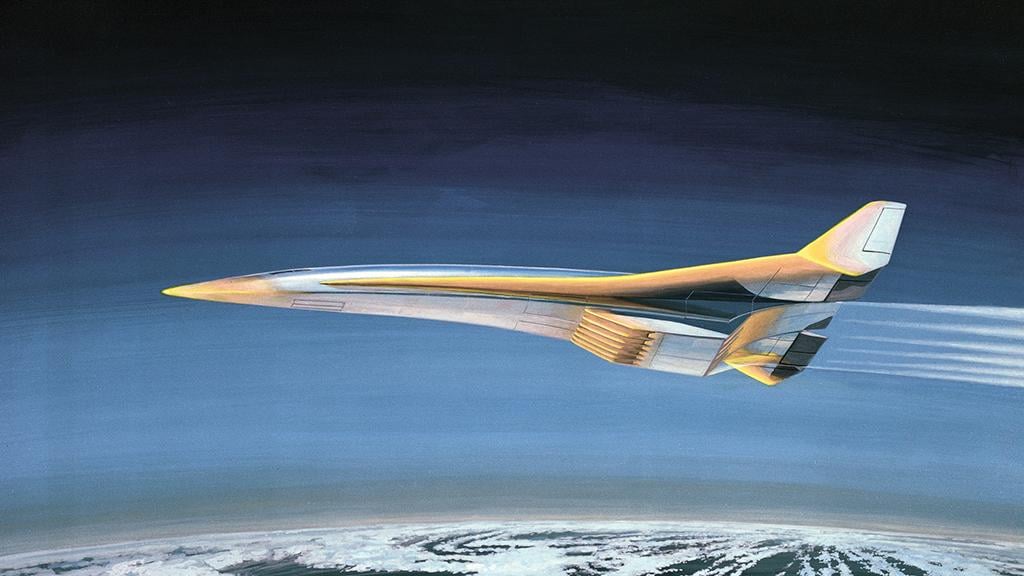This article is published in Aviation Week & Space Technology and is free to read until Jun 07, 2024. If you want to read more articles from this publication, please click the link to subscribe.

DARPA’s proposed aircraft would be powered by high-thrust turbine engines as part of a turbine-based combined-cycle system.
As the U.S. Air Force analyzes options for fulfilling future high-speed strike missions, DARPA has started soliciting industry to prove out essential technology components for a reusable hypersonic bomber prototype that could enter the design phase within five years.
Much about the envisioned Next--Generation Responsive Strike (NextRS) “Y-plane” remains shrouded in secrecy, but a few details have been released. The prototype aircraft design could feature at least one turbine-based combined-cycle (TBCC) propulsion system, rely on conventional jet fuel and be made of high-temperature metal alloys rather than composites.
- The agency targets a thrust range up to 38,000 lb.
- Air Force officials are open to new ideas to follow the B-21
In a revealing clue, the turbine engine at the heart of the TBCC would be sized at 30,000-38,000 lb. in thrust, placing it in the same range as the Pratt & Whitney F119 that powers the Lockheed Martin F-22 or the General Electric F110-GE-132 for the Lockheed F-16 Block 60.
Even in a single-engine configuration, such a thrust level calls for an order-of-magnitude jump in output compared with the scramjet-powered hypersonic cruise missiles scheduled to enter service on Air Force and Navy aircraft by the end of the decade.
The propulsion and structural details for DARPA’s nascent NextRS concept came from two requests for information released since early March, titled “Reusable High Mach Gas Turbine Technologies” and “Weight Efficient Thermally Driven Reusable Airframe Technologies.” A DARPA spokesperson declined to provide additional information, including a request about whether the Y-plane proposal implies the existence of a preceding “X-plane.”
The concept emerges while Air Force plans for reusable hypersonic aircraft are in flux. Less than 18 months ago, Leidos received a $334 million contract to develop the Expendable Hypersonic Multimission ISR (intelligence, surveillance and reconnaissance) and Strike aircraft, also known as Mayhem. But the Air Force Research Laboratory put the project on hold in February, pending the results of a year-long analysis of alternatives for high-speed strike capabilities.
Meanwhile, top Air Force officials say they are open to new long-range strike capabilities besides the subsonic, stealthy Northrop Grumman B-21 Raider, which entered flight testing and low-rate initial production within the past six months.
Although the head of U.S. Strategic Command in February called for buying more than 100 B-21s, Lt. Gen. Richard Moore, Air Force deputy chief of staff for plans and programs, told Congress on March 13 that the current pace of acquisition means there is no need to make a decision on expanding the Raider’s program of record until the mid-to-late 2030s.
Air Force Chief of Staff Gen. David Allvin echoed Moore’s testimony during another congressional hearing on April 16.
“[The B-21] certainly is the future of our bomber force,” Allvin told the Senate Armed Services Committee. “One hundred is the program of record. I think we’re not going to reach that number until probably the mid-2030s and beyond. And before we commit to that being a platform beyond that, I think there are other technological advancements that we would see to be able to augment that and have better mix because, as you know, there’s also a price to pay for them.”
An Air Force spokesperson said Allvin’s remarks were not intended to refer to technologies being considered by Global Strike Command’s analysis of alternatives or DARPA’s NextRS Y-plane concept. “Gen. Allvin was sharing the current details on the B-21 program of record. I wouldn’t read anything into his comments,” the spokesperson said.
Mark Gunzinger, director of future concepts and capability assessments at the Mitchell Institute for Aerospace Studies, tells Aviation Week the B-21 is likely the Air Force’s only bomber option for the foreseeable future. “Of course, new technologies will eventually mature that could lead to a new bomber design, but I suspect that is many decades off,” he says.
If the NextRS program moves forward, it will follow a series of NASA and DARPA efforts to develop a reusable hypersonic propulsion system or aircraft. These included NASA’s X-43C, DARPA’s HTV-3X Blackswift and the Air Force and DARPA’s Advanced Full-Range Engine.
“That’s difficult to do,” Purdue Applied Research Institute CEO Mark Lewis tells Aviation Week. “We got a lot of ideas of how to do it, but no one has demonstrated it yet. And, frankly, it’s hard to do because it’s inefficient.”






Comments